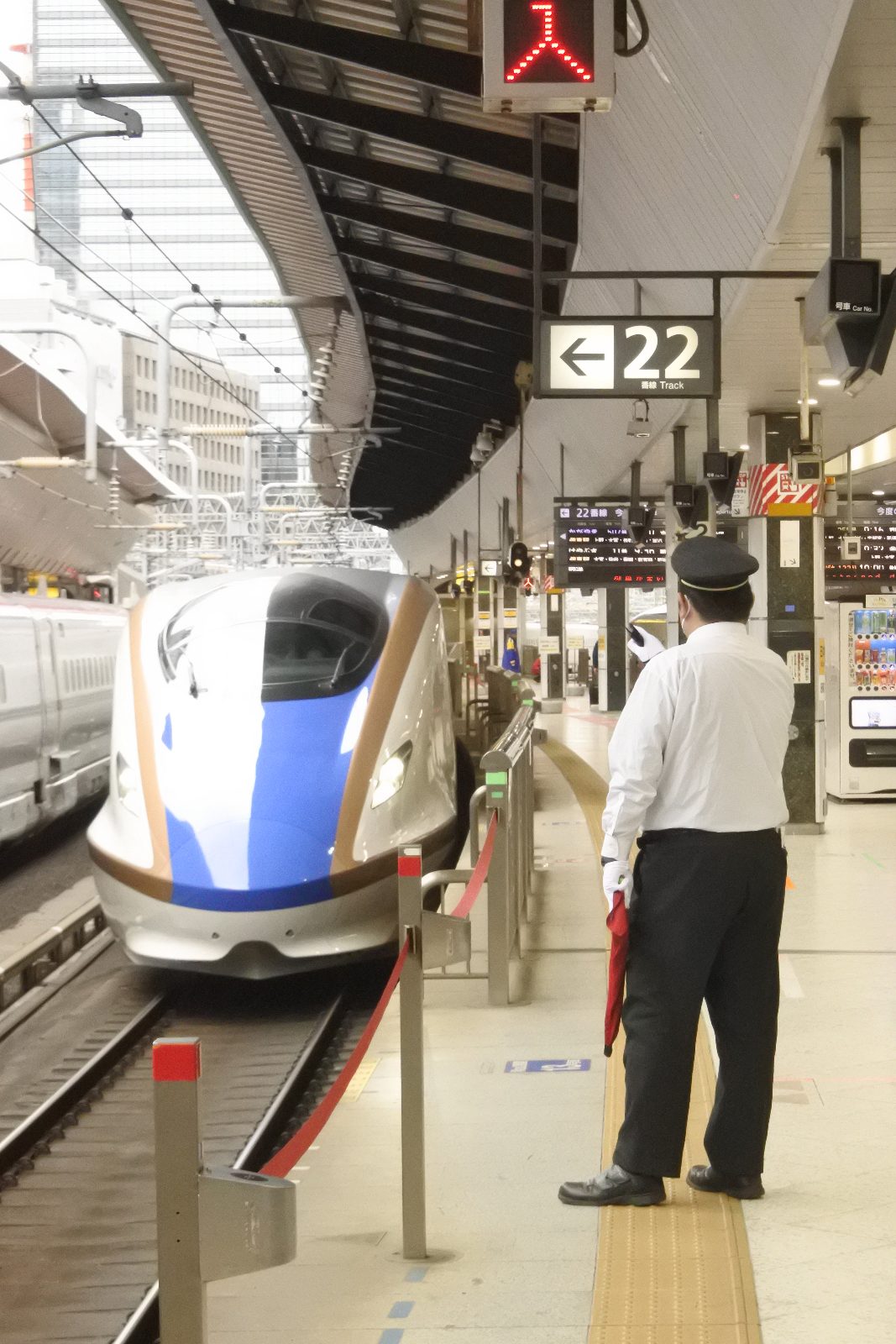
|
|
|
テーマ:鉄道(22077)
カテゴリ:鉄道旅の記録
僕の誕生日であり、このブログの開設記念日でもある12月13日、北陸新幹線「かがやき」のグランクラス席の旅へ出かけた。 北陸新幹線は2019(令和元)年10月の台風第19号で長野新幹線車両センター(幹ナシ)が水没し、同車両基地に停泊されていたE7系電車8編成とW7系電車2編成が廃車となり、メンテナンス機材も一時使用不能に陥る被害を受けた。それ以降、車両不足による列車本数を減らしての運行が続いている。 今回の旅は台風被害よりも前に予定を立てていたものだが、これらの被害の発生を受けて、北陸新幹線を応援する意味合いも込められた。 今回僕が乗った列車は9:20東京駅発の「かがやき507号」。列車は途中上野駅・大宮駅・長野駅・富山駅に停車。終点・金沢駅には11:54に到着。車両はJR東日本E7系新幹線電車F16編成。  車内清掃が終わると側扉が開き、車内へと足を踏み入れる。デッキ部分は、日本の美しい四季を表現した飾り柱が、客室は輪島塗の漆器を想像させるつや消しの赤茶色の化粧板が目を惹く。  E7系のグランクラス車の内装のデザインコンセプトは「人と空間の和」。「伝統を感じる空間と先進の機能を持つシートがお互いを高めあうことで、居心地の良い、ゆとりある空間を感じていただけるように演出している」のだという。座席は電動リクライニングシート。三方を囲まれたバックシェルシートであり、後方を気にしないで背もたれをリクライニングさせることができる。座席間隔も1300mmとしっかりと確保されており、レッグレストをめいっぱい上げても前の座席に足がぶつからない。 当然ながら僕もめいっぱい座席をリクライニングさせた。 9:20、列車は定刻で東京駅を発車。左側に山手線の線路を走るE235系電車を見下ろしながら、金沢駅までの旅が始まった。 上野駅発車後から、アテンダントさんによる車内おもてなしサービスが始まる。最初にブランケットが配布され、続いて軽食と飲み物が届いた。2019(令和元)年12月~2020(令和2)年3月までの軽食は、ベニズワイガニ・カスゴダイ(チダイ)・⼩肌(コノシロ)・いくら・数の子・エビと石川県産棚⽥⽶コシヒカリを使用したばら寿司。飲み物は紅茶をオーダーした。  軽食と紅茶が届けられた頃、列車は大宮駅を発車した。ここから200km/h超のスピードで走り始める。とは言っても、大宮駅~高崎駅間は最高240km/h、高崎駅~金沢駅間は最高260km/hでの運転である。東海道・山陽新幹線「のぞみ」のN700系や東北新幹線「はやぶさ」のE5系・H5系、秋田新幹線「こまち」のE6系のような300km/h以上での運転はせず、近年の新幹線としては控えめなスピードである。そのため、E7系の先頭部分のデザインは、前述の4車種の300km/h以上での走行時のトンネル出口から出る微気圧派(いわゆる「トンネルドン」)を軽減する複雑で幾何学的なものに対して、「ワンモーションライン」と呼ばれるすっきりとした流線形である。 熊谷駅~本庄早稲田駅間では進行方向左側の車窓に秩父の山々が遠くに見えた。本庄早稲田駅を通過すると、利根川橋梁を渡り、群馬県へ入る。 高崎駅から上越新幹線と別れ、北陸新幹線の線路へと入る。高崎駅~安中榛名駅間の上越新幹線との分岐点には「38番分岐器」と呼ばれる160km/hで通過できるポイントがある。 北陸新幹線で一番の“秘境駅”と呼ばれる安中榛名駅を通過し、次の軽井沢駅までは碓氷峠越えの30パーミルという急勾配区間である。新幹線の開業前、1997(平成9)年に廃線になった信越本線の碓氷峠越えの区間、横川駅~軽井沢駅間には、66.7パーミルという国鉄・JRで最もきつい勾配だった。同区間を通過した列車は、EF63形電気機関車2両を補助機関車として横川方に連結して、軽井沢・長野方面行き列車は後ろから押し上げてもらい、高崎・上野方面行きの列車は前に立ってブレーキとなり、速度超過を防いだ。同区間では急勾配を上り下りすることから貨物列車は25km/h、旅客列車では38km/hに制限された。勾配が30パーミルに緩和されたこともあり、在来線時代に通過に多大な苦労を要した碓氷峠を、列車は210km/hというスピードで駆け上っていく。 軽井沢駅の手前で碓氷峠トンネルを抜けて長野県へ入る。軽井沢の高原から浅間山の麓を抜けて、佐久盆地(佐久平)・上田盆地(塩田平)へ。上田駅付近から、車窓に先の台風第19号で氾濫した千曲川が見えた。新幹線の線路はここから飯山駅付近までほぼ千曲川沿いに通っている。再び千曲川を渡り、しなの鉄道しなの鉄道線・JR東日本信越本線篠ノ井駅が進行方向左側に見えると、信越本線の線路と並行し始める。しばらく走ると列車は長野駅に到着した。 長野駅でこれまで乗務していたJR東日本の乗務員さんは、JR西日本の乗務員さんと交代する。北陸新幹線の会社境界駅は2駅先の上越妙高駅だが、「かがやき」が同駅を通過することから、乗務員さんの交代は金沢方面行きのすべての列車が長野駅で行われている。 長野駅を発車すると、北陸新幹線の線路はしばらくしなの鉄道北しなの線と並行する。途中、車窓右側には長野総合車両センター(長ナノ)が見え、かつて中央本線(中央東線)の特急「あずさ」として運行していたE257系電車1編成が留置されている姿が見えた。おそらく特急「踊り子」仕様へのリニューアル待ちの編成であろう。その後、北しなの線の線路と別れると車窓左側にE7系・W7系合わせて10編成120両が水没した長野新幹線車両センターが見えた。廃車となった120両はまだ車両基地内に残っており、僕は120両を弔うために窓越しに手を合わせた。 長野盆地(善光寺平)を抜けて飯山駅を通過するとすぐに、列車は北陸新幹線で最長のトンネルである飯山トンネルに入る。飯山トンネルを抜けるとそこは新潟県であり、間もなく上越妙高駅を通過。ここからJR西日本が管轄する区間に入る。 糸魚川駅を通過した後は姫川橋梁を渡り、数本のトンネルを抜けて境川橋梁を渡ると富山県に入る。富山盆地に入ると、進行方向左側の車窓には山頂に雪をかぶった立山連峰の姿が見えた。黒部川橋梁を渡り、黒部宇奈月温泉駅を通過。さらに片貝川・早月川・常願寺川を渡ると、富山駅に到着した。 新幹線開通を前後して行われている富山駅の改良工事は、2019(平成31)年にあいの風とやま鉄道線ホームの全面高架化が完了し、2020(令和2)年にはいよいよ大詰めと言える、駅の南側を走る富山地方鉄道市内線と北側を走る富山ライトレール富山港線、2つの路面電車路線の線路がつながる予定である。 窓の外には富山市の街並みが見える。2006(平成18)年の富山ライトレール富山港線の開業以降、富山市は路面電車を積極的に活用した街づくりを進めており、富山地方鉄道富山市内軌道線の環状線(3系統)が2009(平成21)年に開業し、新幹線が開業したのと同じ2015(平成27)年には富山駅高架下への乗り入れを実現させるなど、利便性向上に努めている。そのため僕の目には、路面電車の改良と新幹線の開通に伴う再開発により、富山市は北陸地方の三大都市(富山市・金沢市・福井市)の中で最も機能的な街のように見える。 富山駅~金沢駅間は今回初めて乗車する区間である。神通川橋梁を渡り、列車はなおも富山平野を走り抜ける。庄川橋梁を渡ると間もなく新高岡駅を通過。小矢部川橋梁を通過すると新倶利伽羅トンネルに入る。そこを抜けると石川県に入り、金沢駅は間もなくである。 東京駅~金沢駅間2時間34分の贅沢グランクラス車という贅沢空間の旅は、とても素晴らしいものだった。座席は大変素晴らしい座り心地で、軽食のばら寿司も美味しかった。前回の北陸新幹線への乗車はすでに夕方から夜にかけてだったため、車窓からの景色についてほとんど見えず、何も書けなかったが、北関東の山間部から信越の高原地帯を抜けて日本海沿岸へと至る風景をじっくりと見ることもできた。 From December 13th to 15th, I went travelling in Fukui Prefecture by Hokuriku Shinkansen. In October, the typhoon Hagibis, hitting in Japan mainly Tokai, Kanto, Tohoku Areas, and Nagano Prefecture, had caused the submergence of the eight sets of E7 Series and the two of W7 Series Shinkansen staying at Nagano railyard in the rainwater. Because of the lack of carriages, the trains of Hokuriku Shinkansen is in service with fewer operations than the regular one since the typhoon passed. Though I planned this travel before the typhoon had come, I also went to support the Shinkansen. This time I travelled on a Gran Class (first-class) seating "Kagayaki 507" at 9:20 AM, which stopped at Ueno, Omiya, Nagano, and Toyama Stations during its travel between Tokyo Station and Kanazawa Station and operated by E7 Series F16 set. It took two hours and thirty-four minutes from the start to the end. Getting on the train, the red-coloured decorative board in the cabin and those with pictures of symbols of each season in the end sections attracted me. The interior design of E7 Series' Gran Class cabin has the theme of "harmony of passengers and atmosphere" to create passengers' comfort using traditional colours and seatings with advanced functions. The carriage represents three fixed-back shell seatings in a 1+2 layout with a seat pitch of 1.3-metre/4.27-foot. I fully reclined my seat during my travel. Between Tokyo Station and Ueno Station, I could see E235 Series on Yamanote Line below the window. Around the train's departure from Ueno Station, the attendant service started; blanket distribution and boxed meal and drink service. That day's service was sushi rice topped with fish or seafood, such as shucked snow crab, small-sized seabream, konoshiro gizzard shad, and salmon row. I chose a cup of tea. When my meal and drink came, the train departed from Omiya Station. The train started to run at over 200 kilometres/124.23 miles per hour. However, the maximum speed of the train is 240 kilometers/149.13 miles per hour (between Omiya Station and Takasaki Station) or 260 kilometers/161.56 miles per hour (between Takasaki Station and Kanazawa Station) unlike N700 Series "Nozomi" on Tokaido Sanyo Shinkansen, E5 Series and H5 Series "Hayabusa" on Tohoku Hokkaido Shinkansen, or E6 Series "Komachi" on Akita Shinkansen. Because of its maximum speed, E7 Series has a simple streamline shape called "One-motion Line" looking unlike that of the four Shinkansen carriages. Between Kumagaya Station and Honjo-waseda Station, I could see Chichibu Mountains from the left window. After passing Honjo-waseda Station, the train crossed over Tone River, which borders between Saitama Prefecture and Gumma Prefecture. Passing at Takasaki Station, the track of Hokuriku Shinkansen separates from that of Joetsu Shinkansen, where the train can be available to run at 160 kilometres/99.4 miles per hour. Between Annaka-haruna Station and Karuizawa Station, the train went up the steep incline of 30 per mil over Usui Pass, which straddles the border between Gumma Prefecture and Nagano Prefecture. Before Shinkansen's opening in 1997, Shinetsu Main Line train had done the steeper one of 66.7 per mil, which had been the steepest among those of JR Lines. On this section, Class EF63 electric locomotives, which had equipped many safety solutions for passing the steep grade to prevent rollback and runaway, had been in service as bank engines. The Shinkansen train ran at about 210 kilometres/130.49 miles per hour. Going out of the Usui Pass Tunnel, the train passed Karuizawa Station in a few minutes. From there, the train went into Nagano Prefecture, where the railway spreads over the bottom of Mt. Asama, Saku Basin (Saku-daira), Ueda Basin (Shioda-daira), and Nagano Basin (Zenkoji-daira). Crossing Chikuma River twice, the train arrived at Nagano Station, where the train crew from JR East took their place with the others from JR West. Though the operator border of JR East and JR West on Hokuriku Shinkansen is Joetsu-myoko Station, the second station from Nagano, the crew always take place at Nagano because all "Kagayaki" services don't stop there. Departing from Nagano Station, I could see E257 Series at Nagano Railyard on my right and the other E7 Series at Nagano Shinkansen Railyard, some of which were probably the submerged ones, on my left. Soon after passing Iiyama Station, the train went into Iiyama Tunnel, the longest one on Hokuriku Shinkansen on the border between Nagano Prefecture and Niigata Prefecture. In a few minutes after going out of the tunnel, the train passed at Joetsu-myoko Station and went into JR West section. Crossing Sakai River and going out of some tunnels between Itoigawa Station and Kurobe-unazuki-onsen [Kurobe and Unazuki Hot Spring] Station, I could see Mt. Tateyama on my left. The railway crossed many rivers in Toyama Prefecture; Kurobe River between Itoigawa Station and Kurobe-unazuki-onsen [Kurobe and Unazuki Hot Spring] Station, Katakai River, Hayatsuki River, and Joganji River between Kurobe-unazuki-onsen [Kurobe and Unazuki Hot Spring] Station and Toyama Station, Jinzu River and Sho River between Toyama Station and Shin-takaoka Station, and Oyabe River between Shin-takaoka Station and Kanazawa Station. Watching the scenery of Toyama City, it looked the smartest among the three big cities in Hokuriku Area (Toyama, Kanazawa, and Fukui) because of the improvement of the newly-planned structures including the two tramways. On March, 2020, the two, Toyama Chiho Railway Inner City Line in the south and Toyama Light Rail Toyamako Line in the north, are being connected. After crossing at Oyabe River, the last river in Toyama Prefecture, the train went into Shin-kurikara Tunnel on the border between Toyama Prefecture and Ishikawa Prefecture. The train decelerated to arrive at Kanazawa terminal. The comfortableness of Gran Class seating, the taste of the meal, and the scenery made this travel fantastic. お気に入りの記事を「いいね!」で応援しよう
[鉄道旅の記録] カテゴリの最新記事
|